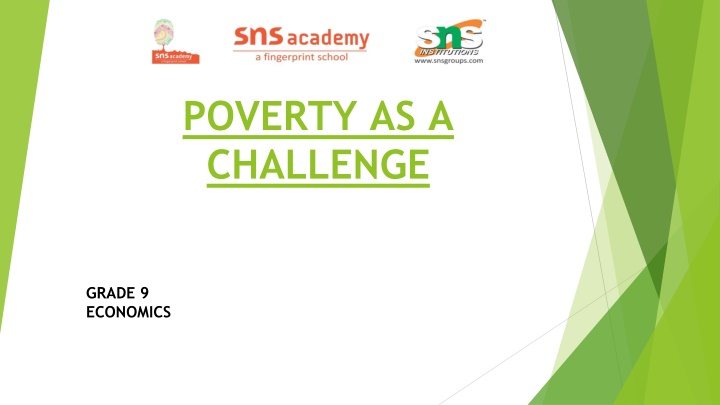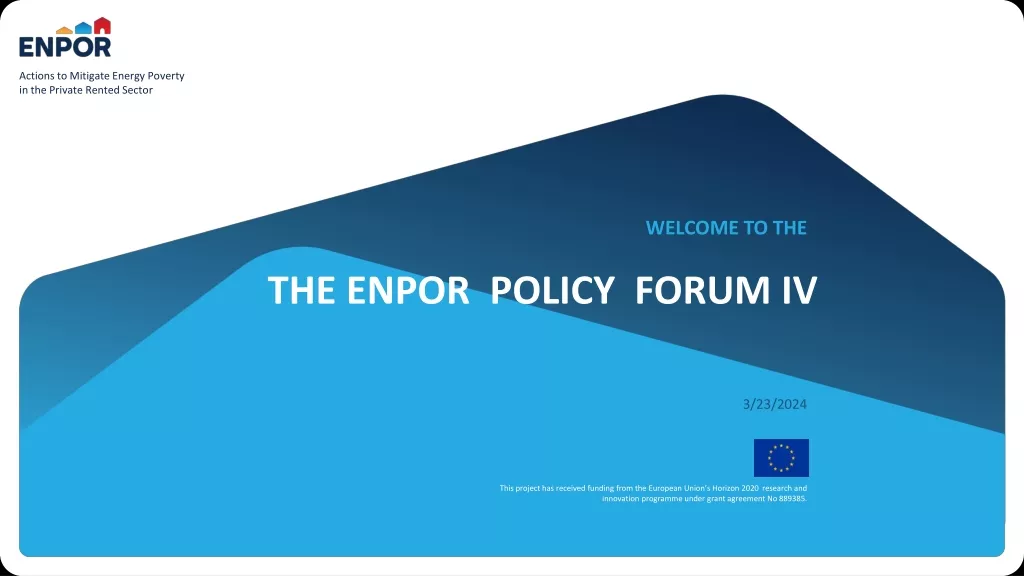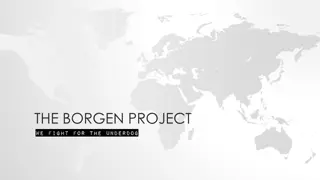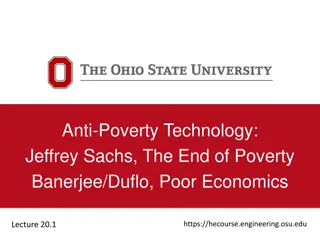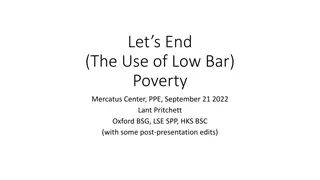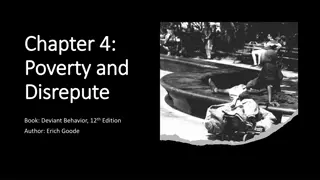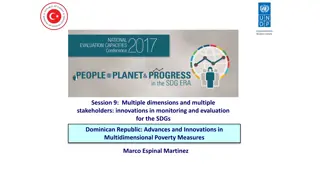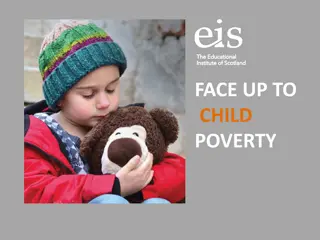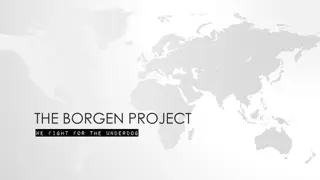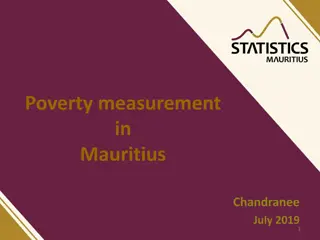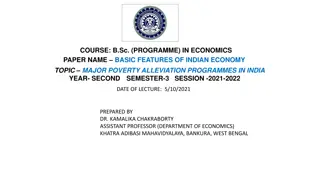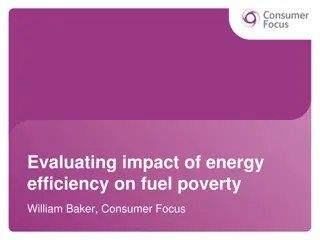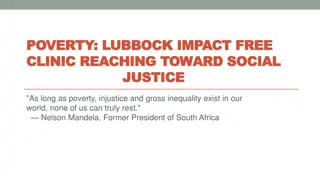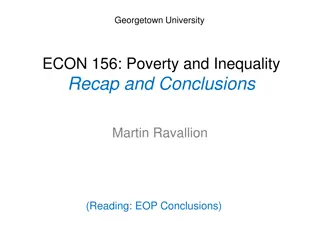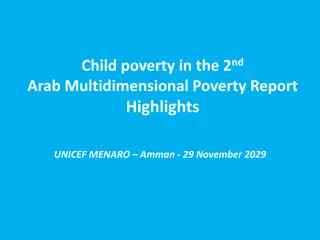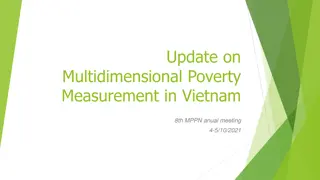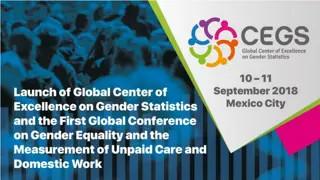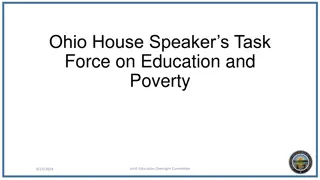Poverty as a Challenge in Economics
Poverty is more than just a lack of money; it impacts basic needs, health, education, and societal participation. Issues related to poverty include unemployment, illiteracy, poor health, and social exclusion based on various factors like caste. Poverty and social exclusion have far-reaching effects, including mental health difficulties and limited opportunities for marginalized groups.
Download Presentation

Please find below an Image/Link to download the presentation.
The content on the website is provided AS IS for your information and personal use only. It may not be sold, licensed, or shared on other websites without obtaining consent from the author.If you encounter any issues during the download, it is possible that the publisher has removed the file from their server.
You are allowed to download the files provided on this website for personal or commercial use, subject to the condition that they are used lawfully. All files are the property of their respective owners.
The content on the website is provided AS IS for your information and personal use only. It may not be sold, licensed, or shared on other websites without obtaining consent from the author.
E N D
Presentation Transcript
POVERTY AS A CHALLENGE GRADE 9 ECONOMICS
WHAT IS POVERTY? Poverty is about not having enough money to meet basic needs including food, clothing and shelter. However, poverty is more, much more than just not having enough money.
DEFINITION OF POVERTY The World Bank Organization describes poverty in this way: Poverty is hunger. Poverty is lack of shelter. Poverty is being sick and not being able to see a doctor. Poverty is not having access to school and not knowing how to read. Poverty is not having a job, is fear for the future, living one day at a time.
POVERTY EXPLAINED In addition to a lack of money, poverty is about not being able to participate in recreational activities; not being able to pay for medications for an illness. Those people who are barely able to pay for food and shelter simply can t consider these other expenses. When people are excluded within a society, when they are not well educated and when they have a higher incidence of illness, there are negative consequences for society. We all pay the price for poverty. The increased cost on the health system, the justice system and other systems that provide supports to those living in poverty has an impact on our economy.
ISSUES RELATED TO POVERTY LANDLESSNESS UNEMPLOYMENT LARGE FAMILIES ILLITERACY POOR HEALTH AND MALNUTRITION CHILD LABOUR
POVERTY AND SOCIAL EXCLUSION According to this concept, poverty must be seen in terms of the poor having to live only in a poor surrounding with other poor people, and they are excluded from enjoying the company of better off people in better surrounding In India social exclusion is practiced on the base of caste and untouchability based exclusion were a group of people being excluded or denial of the rights and opportunities which the majority enjoys. Social exclusion at the individual level results in an individual's exclusion from meaningful participation in society. An example is the exclusion of single mothers from the welfare system prior to welfare reforms of the 1900s.
EFFECTS OF SOCIAL EXCLUSION Poverty and social exclusion are also likely to lead to an increased risk of mental health difficulties, such as the result of stress or managing on a low income, living circumstances, local environment, discrimination and decreased opportunities for positive self-esteem. Those who belong to socially excluded groups are not only affected by a lack of resources 'just like' the rest of the poor. Because social exclusion locks people out of the benefits of development, denying them opportunities, choices and a voice to claim their rights, it causes greater levels of poverty.
SOCIAL EXCLUSION: BOTH A CAUSE & A CONSEQUENCE Social exclusion is a cause of poverty because if the people are poor they don't have good sanitation, proper hygiene and religious beliefs which ultimately leads to being excluded by the rich and economically well established. Its a consequence because if the people are excluded they will not be able to get info about what's happening. they are not able to have trade or any other thing. Ultimately they become poorer.
VULNERABILITY The phrase 'vulnerability to poverty' means that certain groups or communities have a greater probability of either becoming poor or remaining poor in the next few years. The poor are more vulnerable than any other group to health hazards, economic down-turns, natural catastrophes, and even man-made violence. Shocks such as illness, injury and loss of livelihood have dreadful impacts, and are significant causes of poverty. Poverty is a major contributor to vulnerability. Poor people are more likely to live and work in areas exposed to potential hazards, while they are less likely to have the resources to cope when a disaster strikes. In richer countries, people usually have a greater capacity to resist the impact of a hazard.
PEOPLE MOST VULNERABLE TO POVERTY An individual is vulnerable to poverty when she or he is at risk of becoming poor or at risk of remaining poor. Social groups which are most vulnerable to poverty are scheduled caste and scheduled tribe households. Similarly, among the economic groups, the most vulnerable groups are the rural agricultural labour households and the urban casual labour households.
POVERTY LINE Poverty line is the level of income to meet the minimum living conditions. Poverty line is the amount of money needed for a person to meet his basic needs. It is defined as the money value of the goods and services needed to provide basic welfare to an individual. Poverty line differs from one country to another, depending upon the idea of poverty Poverty is relative and what poverty in the US or in an advanced West European country may not be poverty in Bangladesh.
VARIATION IN POVERTY LINE Poverty line changes from one country to another. In developed countries, where there is advanced standard of living and welfare concepts, poverty line is high as basic standard to live include higher consumption requirements and accessibility to many goods and services. On the other hand, in many less developed countries, the basic requirements will be low and contains mostly essential consumption items needed to sustain life. This means that poverty line is set by the welfare standard in a particular society (economy).
POVERTY LINE IN INDIA For measuring poverty, a poverty line is set. The poverty line is the level of income needed to meet the minimum standard of living. People who have an income less than this is considered as below poverty line. The concept about minimum consumption standards and consumption levels were changed based upon recommendations of the various expert groups/task force. These expert groups uses the NSS (National Sample Survey) estimate about the consumption pattern of households from time to time. Here, from the preferred consumption basket of the people, the expert groups pick up the most essential commodities. These commodities are placed under a poverty line basket (PLB).
POVERTY LINE IN INDIA Minimum standard of living is thus expressed as the basket of goods and services commonly used by the people. Based on this consumption pattern, the Expert Groups estimate the minimum consumption levels (and the income needed to buy these) and the income needed to obtain these goods and services in both rural and urban areas. This income level acts as the poverty line. Poverty ratio is measured in terms of per capita consumption expenditure over a month.
WHAT IS THE INTERNATIONAL POVERTY LINE? The international poverty line is a monetary threshold under which an individual is considered to be living in poverty. I t is calculated by taking the poverty threshold from each country given the value of the goods needed to sustain one adult and converting it into dollars. The current international poverty line is $1.90 per day.
INTERNATIONAL POVERTY LINE The World Bank sets the international poverty line at periodic intervals as the cost of living for basic food, clothing, and shelter around the world changes. In the 2008 update, the poverty line was set at $1.25 per day. In 2015, the threshold was updated to $1.90 per pay, which is where it currently stands According to the World Bank, in 2012, more than 900 million people were estimated to be living under the international poverty line. Based on data projections, the World Bank also estimated that more than 700 million people lived in extreme poverty as of 2020.
POOREST OF THE POOR In poor families, all suffer but some suffer more than the others They do not have equal access to the available meagre resources and are systematically denied from getting an equal share. Women, elderly people and female infants are the poorest of the poor is society. Women, elderly people and the girl child are systematically denied equal access to the resources available in the family. That is why they and considered the poorest of the poor.
INTER STATE DISPARITIES In India a lot of inter state disparities can be observed as far as poverty is concerned The proportion of poor is not the same in every state Madhya Pradesh, Bihar, Assam, Uttar Pradesh and Odisha had above all India poverty level In 2011-12 Bihar and Odisha continued to be the poorest states with 33.7 and 32.6 percent poverty respectively Along with rural poverty, urban poverty is also high in Odisha, Madhya Pradesh, Bihar and Uttar Pradesh
Different states have conquered poverty in different ways Tamil Nadu and Andhra Pradesh have focussed on Public distribution system and food security Punjab and Haryana have managed to get out of poverty due to agricultural practices like the Green Revolution West Bengal has focussed on land redevelopment measures Other states have still been far behind with Bihar, Odisha, Jharkhand, Chattisgarh etc having high levels of poverty
GLOBAL POVERTY SCENARIO Globally poverty levels have come down in the past 3 decades The World Bank defines poverty as people living on less that $1.90 per person per day China has been one of the countries with fastest reduction in poverty 88.3% in 1981 to 14.7% in 2008 to 0.7% in 2015 Other South East Asian countries have also managed to come out of poverty as a result of rapid economic growth and massive investments in human resource development South Asian countries (India, Pakistan, Bangladesh, Nepal, Bhutan) have seen a slower decline in poverty ratios because economic development has not been as rapid
Sub Saharan Africa has seen a decline from 51 % in 2005 to 41 % in 2015 Latin America has seen a decline from 10% in 2005 to 4% in 2015 Poverty has resurfaced in former socialist countries like Russia where it was unheard of earlier Un aims to end global poverty of all types by 2030
CAUSES OF POVERTY BRITISH COLONIAL RULE: It led to the decline of the handicraft industry. People were left without job. The apathy and the unfair policies of the British government left a large number of people unemployed and poor. THE SLOW ECONOMIC GROWTH AND GROWING POPULATION: The slow economic growth that began during the colonial era went on right till the early 80s. At the same time the population of the country grew by leaps and bounds. The economy was not able to bear the burden of the growing population which led to large scale poverty Green revolution helped but it was limited to only certain parts of the country Both private and public sector were not able to absorb the large number of job seekers
CAUSES OF POVERTY Lack of education and training forced people to take up unskilled jobs. These incomes were not enough to give a decent standard of living. People started living in slums on the outskirts of the cities. Thus poverty which was largely a rural problem became an urban problem also HUGE INCOME INEQUALITIES: Unequal distribution of land as well as other resources. Despite many policies, this issue still persists Major policies like redistribution of land in rural areas have not been really successful. Thus majority of Indian poor are left with absolutely no resources SOCIO-CULTURAL FACTORS: In order to fulfil social obligations, even the poor spend huge amounts of money ( marriage, birth of a child, religious ceremonies etc). When they don t have enough money, they borrow, mostly from the money lenders
CAUSES OF POVERTY ECONOMIC FACTORS: Majority of the farmers are small or marginal farmers. In order to practice agriculture every year, they are forced to borrow money. Many times in the absence of banks in rural areas as well as other formalities like documentation etc, these farmers are forced to borrow money from informal sources at extremely high rates of interest. Since most of the agriculture is still based on the monsoon, many times the crops fail. Thus farmers come under the crippling burden of debt which is known as debt trap. Debt trap is also a major cause of poverty. Indebtedness thus becomes a cause as well as an effect of poverty
ANTI POVERTY MEASURES The current anti poverty strategy is broadly based on two planks: Promotion of economic growth where we are aiming to increase the growth of the various sectors in the economy. Economic growth leads to employment opportunities and thus increased consumption and better standards of living. The more the economic growth, the better people earn. It widens their opportunities. They are able to spend more on education, health, welfare of girl child etc Targeted anti poverty programmes: The government is trying to target specific groups and then work for their betterment and upliftment. It makes anti poverty strategies targeting specific groups of people (scheduled caste, scheduled tribes households, rural women, youth in villages and small towns etc
ANTI POVERTY PROGRAMMES MGNREGA: Mahatma Gandhi National Rural Employment Guarantee Act (2005) PMRY: Prime Ministers Rozgar Yojana (1993) REGP: Rural Employment Generation Programme (1995) SGSY: Swarna jayanti Gram Swarozgar Yojana (1999) Results: Some of the programmes have been successful but many of them have proved to be failures. They overlap, lack of proper implementation and right targeting, it has not reached the deserving poor due to mismanagement and widespread corruption
CHALLENGES AHEAD Poverty has declined but it is still a major concern for India. There are huge disparities observed which widens the gap between the rich and the poor The more the gap, the more difficult it becomes to break the vicious cycle of poverty Hence India should aim at bridging the gap between the rich and the poor Also there are huge variations based on geographical regions. Certain states have always been poor and continue till date. So we need a more balanced approach towards national development Certain caste based and gender based discrimination is still observed in many parts of the country, which needs to be bridged
CHALLENGES AHEAD We should focus on the basics like universal free elementary education, declining population growth, increasing women empowerment, working for the socially and economically backward sections of the economy The concept of poverty needs to undergo a sea change. Even now we see poverty as absent if the basic necessities are taken care of. But we must broaden our definition of poverty from bare minimum subsistence level to a reasonable level. It is not only about food clothing and shelter. It must also include dignity, self esteem, confidence, no discrimination on any basis. It should always take into consideration human poverty.
THANK YOU REFERENCE NCERT BOOK
